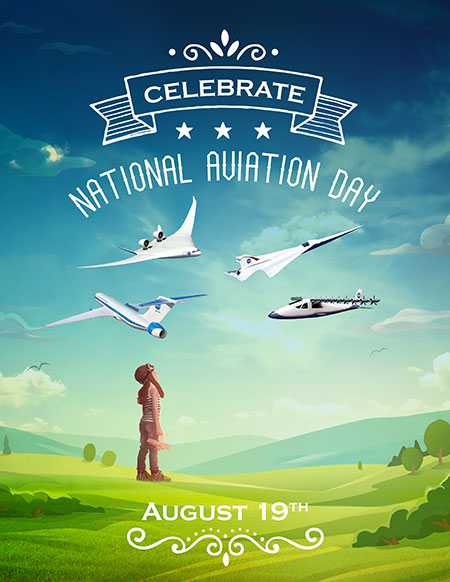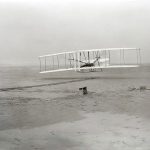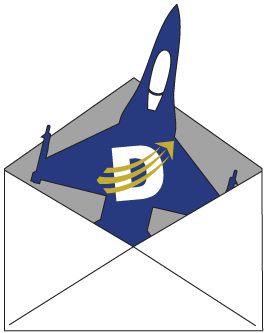August 19 is National Aviation Day
In 1946, Congress established National Aviation Day “to commemorate the Wright brothers’ first successful flight at Kitty Hawk, North Carolina, on December 17, 1903.” The Wright brothers successfully made the first powered flight in history on December 17, 1903. National Aviation Day is a time to celebrate aviation and its contributions to our economy and way of life.
 What is National Aviation Day and why is it celebrated on August 19th?
What is National Aviation Day and why is it celebrated on August 19th?
In 1939, President Franklin Delano Roosevelt established National Aviation Day by presidential proclamation. The significance of August 19 day is that it is the birthday of Orville Wright, who along with his brother Wilbur, is considered the father of aviation. The Wright brothers are widely regarded as the inventors of the airplane. After four years of research and design, they succeeded in flying a 120-foot, 12-second flight at Kitty Hawk, North Carolina on December 17, 1903. The Wright brothers made the first powered and controlled flight in a heavier-than-air flying machine called the Wright Flyer. Before then, people had only flown in gliders and balloons.
On this day, we celebrate the history and accomplishments of aviation. From the Wright brothers’ first flight to today’s advanced aircraft, aviation has come a long way. This day is also an opportunity to recognize the important role that aerospace and defense play in our economy and national security.
6 Facts About National Aviation Day and Celebrating Flight
- Wright Brothers – From their bicycle shop in Dayton, Ohio, Wilbur and Orville Wright invented and built the first controlled powered heavier-than-air aircraft, which they flew for 12-seconds in Kitty Hawk, NC
- The Aeroplane’s first war was the Italo-Turkish War – The first use of an airplane in war was on October 23, 1911, during the Italo-Turkish War. On that day, an Italian pilot flew a Blériot XI monoplane for one hour over enemy positions near Tripoli, Libya. This was the first time that an airplane had been used for reconnaissance in war. The Italian army was able to use the information gathered by the pilot to make better decisions about their next move in the war. In the years that followed, the use of airplanes in warfare became increasingly commonplace. They were used for reconnaissance, bombing, and even dogfights between opposing pilots.
- Mail Delivery – On May 14, 1918, the first airmail flight left Belmont Park, Long Island, for Philadelphia. The U.S. Army and Post Office continued to develop transcontinental air services to make use of the large surplus of WWI war aircraft. Over the next few years, airmail service was expanded to include several cities on the East Coast. In 1925, the first airmail delivery between New York and San Francisco was made. By 1927, regular airmail service was established between New York and Chicago. In 1930, the first air passenger service was inaugurated between New York and Los Angeles.
- First Trans-Atlantic Flight – On May 20, 1927, Charles Lindbergh became the first pilot to cross the Atlantic Ocean from New York to Paris. His successful transatlantic non-stop flight in an airplane sparked investor interest in the aviation industry and made him an American hero. Lindbergh’s flight took 33 hours and 29 minutes before landing at Le Bourget Field, outside Paris, France.
- First Woman to Cross the Oceans – Amelia Earhart was one of the most accomplished aviatrices of her time. She was the first woman to cross the Atlantic and Pacific oceans by airplane, and she was also a noted author and lecturer on aviation. In 1937, she embarked on a flight around the world, but she disappeared during the attempt. Although Earhart’s fate remains a mystery, her legacy as a trailblazer in aviation endures. She inspired countless women to pursue their dreams and explore the possibilities of flight. Her courage and determination continue to inspire people today, and she is remembered as one of the most significant figures in aviation history.
- First Commercial Aviation – In the early 1930s, the first modern passenger airliner, the Boeing 247, took to the skies. This sleek new aircraft could carry 10 passengers and fly at 155 miles per hour, making air travel more efficient and accessible than ever before. In 1936, American Airlines designed the DC-3 model, which quickly became the dominant commercial aircraft in the United States. This rugged plane could transport both passengers and cargo, and it quickly proved its worth during World War II when it was used extensively by the military. In 1969, Pan Am acquired the Boeing 747 and became the first airline to fly this massive new aircraft in commercial service. The 747 could accommodate up to 450 passengers, making it ideal for long-distance travel. With its sleek design and spacious interior, the 747 helped to transform air travel into a luxurious experience.
National Aviation Day is not only about celebrating the history of flight. It is also a day to salute the men and women who work every day to make aviation safe and efficient.
Be sure to check out your local airports or museums for exhibits and other activities related to aviation. Whether you’re a fan of flying or not, National Aviation Day is definitely worth celebrating!









